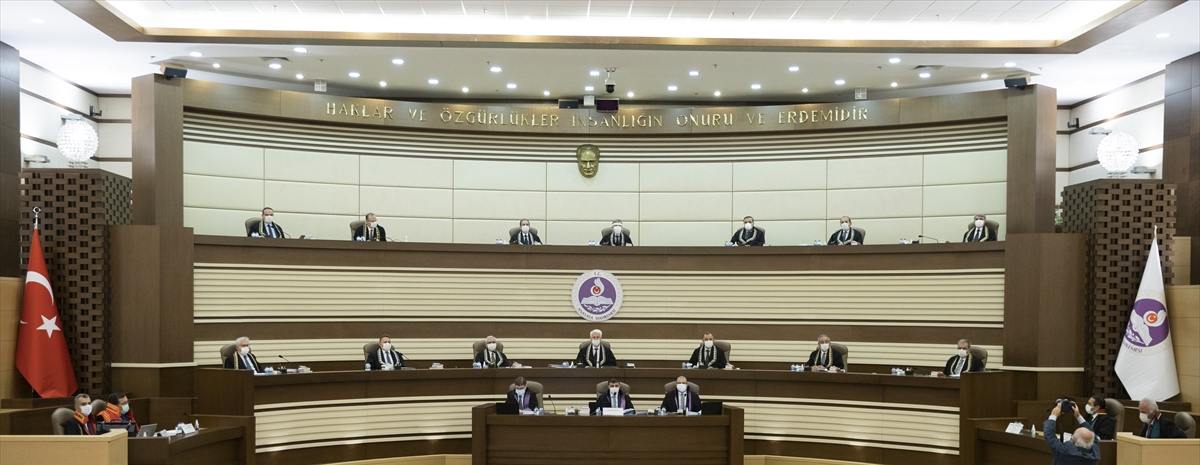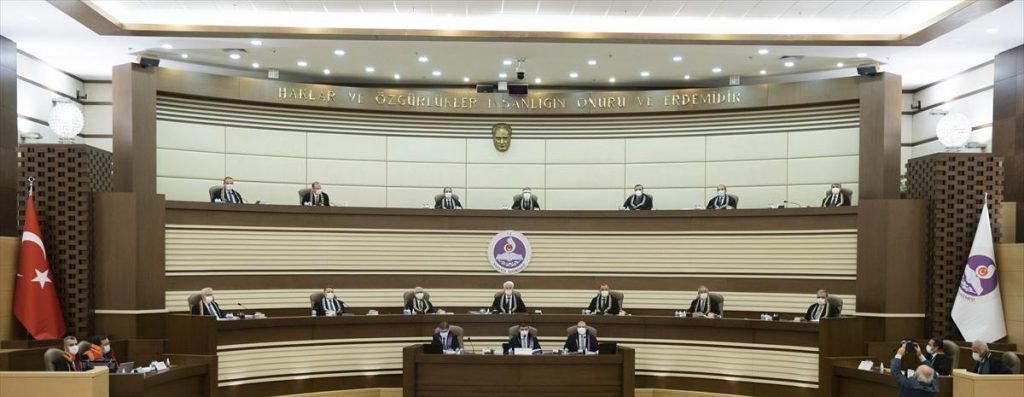

The Turkish Constitutional Court announced on 10 October 2023 that it will cease to examine and will dismiss individual applications related to violations of the right to a fair trial within a reasonable time. (Photo: AYM)
Turkiye’s Constitutional Court (AYM) announced in the Official Gazette on October 10, 2023 in its Keser Altıntaş decision that it will cease to review and will dismiss individual applications related to violations of the right to be tried within a reasonable time.
The decision of the AYM General Council dated 25 July, with 9 in favour and 3 dissenting, officially identifies, rubber-stamps, and proclaims that the judiciary cannot carry out fair trials within a reasonable time, the right is systematically violated, and that the judicial system has virtually collapsed in this regard, obliterating all prior work on the judiciary done so far.
The AYM, stating that “[the] violations arise from a structural problem,” arbitrarily dismisses Keser Altıntaş’s individual application, which it is required to automatically accept, and will similarly dismiss others.
What is reasonable time?
The European Commission for the Efficiency (and productivity) of Justice (CEPEJ) established under the Council of Europe, of which Turkey is officially a member, has defined reasonable time for trial as one year to a maximum of three years. According to the application guide adopted by the CEPEJ General Assembly on the conclusion of trials within a certain period, member countries are advised to conclude cases in one, two, and three-year periods, however the stated main goal is one year. According to the AYM’s past decisions trials lasting more than 4 years are violations of the right to be tried within a reasonable time.
The AYM does not explain or fix the structural problem
AYM describes its duty concerning individual applications as “identifying structural and systemic problems and preventing new violations by adjudicating on these issues.” However, in the Keser Altıntaş decision, the AYM avoids both its duty of “identifying the problem” and that of “preventing new violations by adjudication”.
The AYM, which complains about the accumulation of individual applications, is not trying to find individual if not a collective solution to these applications. By calling the cause of the violations “a structural problem” it casts the reasons into arcane obscurity preventing others from finding a solution to the problem it avoids untangling.
The fallacy of the Constitutional Court members
It is disturbing that the AYM exempts itself from its duty and dismisses an individual application by overlooking Articles 6 and 10 of the Constitution and the hierarchy between Law No. 6216 and the Internal Regulations.
The aim and scope of the Internal Regulation prepared by the Constitutional Court are to “regulate the internal order, functioning, organization, working, trial procedures, and principles [and other matters] of the Constitutional Court.” It is unacceptable for the AYM to interpret this to suit its whims.
Finding the Compensation Commission established for applications made until March 9, 2023, as temporary, the Court stated in the 68th Paragraph of the Keser Altıntaş decision: “We have identified a structural issue concerning the lack of an “effective means of application” to remedy the damages of violations of the right to fair trial in reasonable time, despite all measures taken regarding it. We have referred for solution this constitutional matter to the Grand National Assembly of Turkey (TBMM). In doing so we have fulfilled our constitutional obligations.”
The desired effective application path is AYM itself
As is known, the “individual application path to the AYM” was introduced as a result of negotiations with the European Court of Human Rights (ECHR) upon the excessive accumulation of individual applications from Turkey in the past. The ECHR accepted this as an effective domestic remedy. The then Minister of Justice, Sadullah Ergin, explained this situation by saying, “We proposed to resolve the complaints arising from long trials not by the ECHR but by means of domestic law to be established in Turkey. The ECHR accepted our proposal. They offered us a pilot application.” And now the AYM is requesting the introduction of another path to remedy to precede itself.
In the current situation, the AYM, which desires the TBMM to introduce an effective application path, is ignoring the fact that it was itself established as an effective application path.
Concealing the structural problem
The Constitutional Court acts as if it is instructing the TBMM to enact a law in a specific manner. In my opinion, this is because the AYM interprets the term “structural problem” contrary to its meaning. A structural problem can only be a problem found in the existing structure. For example, deficiencies in procedural laws, constitutional and legal regulations that restrict independence, provisions that limit the accountability of those who commit violations, and disrupt merit, can be structural problems; not the absence of a law the AYM desires!
The Court considers the prolongation of court trials as normal and sees the lack of a permanent application path to compensate for the damages incurred as a structural deficiency. The Court approach is akin to trying to treat cancer with aspirin. The Court should abandon this mentality; it should identify the problems causing the delay in trials, which are very long according to CEPEJ standards, and solve them itself.
AYM does not see the root causes
The systemic violation of a reasonable trial period is not too difficult to see. These structural problems include (i) restricting lawyers’ rights to collect evidence and complete case files; (ii) limiting the parties’ rights to find their own experts and obtain reports, obligating this to the courts; (iii) preventing parties from discussing their claims, defences, evidence, and expert opinions face to face at an oral hearing; (iv) not resolving cases in a single oral hearing.
The Constitutional Court can easily eliminate all these causes by repealing the relevant restrictive provisions in the laws. Instead, the Court is waiting for palliative solutions, such as setting up a compensation mechanism and transferring files to a commission, to become permanent.
Compensation is not enough to remedy the violation
Both the Constitutional Court and the Compensation Commission, which handles the glut of applications, violate universal legal principles by refraining from compensating victims for their real damages; instead, awarding symbolic compensations.
Victims who have spent years in courts for their cases, paid significant fees and expenses, wasted their valuable time and effort on never-ending cases instead engaging in productive pursuits, and suffered material and emotional losses, are left uncompensated for even a small fraction of their damages.
Indeed, an individual application of a client whose unfair competition case did not conclude for 15 years was found justified. And yet, despite having suffered damages exceeding 400,000 EUR, the Compensation Commission decided on a compensation of 20,000 TL.
Will the state and officials, who are not held accountable for the damages they caused, end these human rights violations and solve these structural problems?
The Constitutional Court is not the ECHR
The Constitutional Court is trying to resemble the European Court of Human Rights (ECHR).
However, the ECHR is an international court with no direct jurisdiction over domestic law, while the Constitutional Court has direct influence in domestic law. Unlike the ECHR, the Constitutional Court can repeal provisions causing violations. Thus, the Constitutional Court can directly eliminate the structural problem causing human rights violations.
Yet, in its Nevriye Kuruç decision, trying to emulate the ECHR, the Constitutional Court notified the TBMM. The Court believes it has fulfilled its duty with this notification. However, this approach takes the Constitutional Court negates its judiciary role, reducing it to being just another political actor in the country.
Members of the Constitutional Court cannot shirk their duty
The Court must develop creative methods to perform its duty, request the resources it requires, and fulfil its obligations no matter what.
Seeing as there is a systematic violation of rights due to a structural problem, then all individual applications within this scope should automatically be deemed justified by the Constitutional Court. Even if the Court can’t act on this, it should ensure that the damages caused by the violation are fully compensated and allow citizens to collect a reasonable compensation immediately and further to determine and collect any further amounts through litigation.
The excuse that there are too many cases and not enough time for them is nothing more than pretence to excuse the pursuit of comfort. It is clearly unlawful for the Constitutional Court to shirk its duty by reason of its internal regulations. The Constitutional Court is not a place for irresponsibility, arbitrariness, or comfort. Those who can’t fulfil their duties should account for their failures and make way for those who can.
Cases should be concluded within a reasonable period
According to Article 6 of the European Convention on Human Rights, disputes related to civil rights and obligations and criminal charges must be decided within a reasonable time. A reasonable time, according to the CEPEJ, is one year and at most three years.
According to the Constitutional Court, pursuant to Articles 36 and 141 of the Constitution, the state must take all necessary measures to conclude disputes and cases within a reasonable period, and structure the judicial system and courts to decide cases within a reasonable timeframe.
The truth is, with proper management, all cases in Turkey could be concluded not in one year as targeted in the CEPEJ guide but in a much shorter period of 3-5 months.
To achieve this, the necessary steps are quite simple:
(i) ensure the parties and their lawyers act with integrity from the moment a dispute arises and provide accurate and complete statements;
(ii) ensure complete disclosure of evidence for dispute resolution, and if not disclosed, allow lawyers to collect it quickly and without abuse;
(iii) stop using experts as auxiliary judges and allow parties to find and instruct them;
(iv) ensure that witnesses’ statements are taken in writing before the case starts;
(v) encourage parties to settle and reconcile before the case begins;
(vi) ensure that cases brought to court are well-prepared and ready for immediate trial;
(vii) conduct a single oral hearing face to face and make an immediate decision.
How should it be done?
The establishment of judicial preparatory courts to prevent the abuse of the pre-trial process, and the taking of effective protective precautionary measures can preserve the subject of the dispute and direct the parties to reconciliate and compromise. If this system is adopted, the courts’ workload and the judiciary’s burden would decrease by an order of magnitude, and the duration of lawsuits will decrease to 3-4 months. The number of courts would decrease from 7,000 to around 2,000; the number of judges would decrease from 24,000 to around 8,000. At the same time, the efficiency of the judiciary would be increased tenfold. This would also strengthen societal reconciliation and solidarity many times over, potentially boosting national income three or fourfold at once.
If there’s a problem, there’s a solution
There is no issue Turkey cannot overcome, including those in with judiciary; it has adequate human resources, bittersweet experience, the desire to solve problems, and a very promising future when they are solved.
However, for the solution to materialize, the problem must be identified honestly, its root causes truthfully revealed, and proposed solutions evaluated from a non-partisan perspective.
But above all, the Constitutional Court must not shy away from its duty. Instead of seeing it as an individual burden, it should see it as an opportunity for a solution. Instead of deciding to dismiss, it needs to examine each issue in detail, and produce empirical data for solutions.
Translated by Charles Ediz Gün

